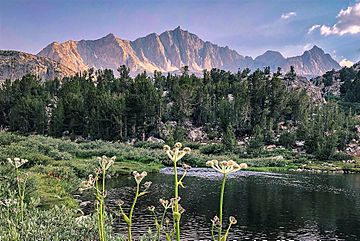Mount Goode (California) facts for kids
Quick facts for kids Mount Goode |
|
|---|---|

North aspect, from Long Lake
|
|
| Highest point | |
| Elevation | 13,085 ft (3,988 m) |
| Prominence | 845 ft (258 m) |
| Isolation | 1.64 mi (2.64 km) |
| Parent peak | Mount Gilbert (13,106 ft) |
| Naming | |
| Etymology | Richard Urquhart Goode |
| Geography | |
| Location | Fresno County / Inyo County California, U.S. |
| Parent range | Sierra Nevada |
| Topo map | USGS North Palisade |
| Type of rock | granite |
| Climbing | |
| First ascent | July 16, 1939 by Chester Versteeg |
| Easiest route | class 2 Southeast slope |
Mount Goode is a 13,085-foot-elevation (3,988 meter) mountain summit located on the crest of the Sierra Nevada mountain range in California, United States. It is situated on the shared boundary of Kings Canyon National Park with John Muir Wilderness, and along the common border of Fresno County with Inyo County. It is also approximately one mile west-northwest of Bishop Pass, and 16 miles (26 km) west of the community of Big Pine.
Contents
History
This mountain's name and position were officially adopted in 1926 by the U.S. Board on Geographic Names based on a recommendation by the Sierra Club. The name commemorates Richard Urquhart Goode (1858–1903), geographer for the United States Geological Survey, in charge of the Pacific Division, Topographic Branch. The first ascent of the peak was made July 16, 1939, by Chester Versteeg, a prominent Sierra Club member.
Climbing
Established rock climbing routes on Mount Goode:
- Southeast Slope – class 3 – First Ascent 1939
- West Ridge – class 5.4
- No Goode – class 5.4 – 3 pitches
- North Buttress – class 5.9 – 9 pitches – FA 1974
- Goode Earth – class 5.10 – 6 pitches
- Sky Pilot – class 5.11 – 6 pitches – FA 2014
Climate
According to the Köppen climate classification system, Mount Goode is located in an alpine climate zone. Most weather fronts originate in the Pacific Ocean, and travel east toward the Sierra Nevada mountains. As fronts approach, they are forced upward by the peaks, causing them to drop their moisture in the form of rain or snowfall onto the range (orographic lift). Precipitation runoff from this mountain drains west into the Kings River, and east to Owens River via Bishop Creek.
Gallery
Images for kids








